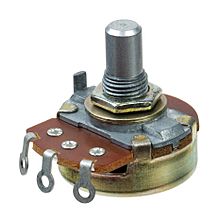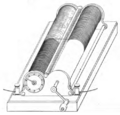Potentiometer facts for kids

A typical single-turn potentiometer
|
|
| Type | Passive |
|---|---|
| Electronic symbol | |
A potentiometer is a special kind of resistor where you can change its resistance. Think of it like a dimmer switch for electricity! You can change how much electricity flows through a circuit by turning a knob or sliding a control.
Potentiometers are used in many everyday devices. They help you control the volume on your radio or TV. They can also make lights brighter or dimmer in your home.
The idea for a device that could control electricity was explored by many people. However, the carbon potentiometer we often use today was invented by Thomas Edison in 1872. He was 25 years old at the time. He first called his invention a "coiled resistance wire rheostat."
Contents
What a Potentiometer Does
A potentiometer works by changing the path electricity takes. Inside, there's a resistive material, like a track. A moving part, called a "wiper," slides along this track. When you turn the knob or move the slider, the wiper changes its position. This changes the length of the resistive track that the electricity has to travel through.
- Longer path: More resistance, less electricity flows.
- Shorter path: Less resistance, more electricity flows.
This simple idea allows you to precisely control things like sound volume or light brightness.
Types of Potentiometers
There are several types of potentiometers, each made with different materials. The most common ones are carbon, plastic, and wire-wound types.
Carbon Potentiometers
Carbon potentiometers are the most widely used today. They are popular because they are cheap to make and easy to put together. The resistive track inside these is made from a special carbon material. You'll find them in many electronic gadgets, like radios and televisions.
Wire-Wound Potentiometers
Wire-wound potentiometers are usually more powerful than carbon ones. Inside, they have a wire that is carefully coiled. This design allows them to handle more electrical power. They are often used in applications where more current needs to be controlled.
Plastic Potentiometers
Plastic potentiometers offer good quality. They are made from a special type of plastic that conducts electricity well. While they handle similar power levels to carbon potentiometers, they often last longer.
Trimmer Potentiometers
Trimmer potentiometers, often called "trimpots," are very small potentiometers. They are usually found inside electronic devices. They are not meant for you to adjust often. Instead, they are set once during manufacturing or repair to fine-tune a circuit.
How Potentiometers Are Used
Potentiometers are very versatile electronic parts. They are used in countless devices to give users control.
- Volume Control: On radios, TVs, and audio mixers, potentiometers let you turn the sound up or down.
- Brightness Control: They can dim or brighten lights, like on a lamp or a car dashboard.
- Position Sensors: Some potentiometers are used to sense movement or position. For example, they might be used in joysticks or robotic arms to tell a computer how far something has moved.
- Musical Instruments: Electric guitars and keyboards use potentiometers to control tone, volume, and other effects.
Images for kids
-
Cutaway drawing of potentiometer showing parts: (A) shaft, (B) stationary carbon composition resistance element, (C) phosphor bronze wiper, (D) shaft attached to wiper, (E, G) terminals connected to ends of resistance element, (F) terminal connected to wiper. A mechanical stop (H) prevents rotation past end points.
-
Slide potentiometers (faders)
-
Charles Wheatstone's 1843 rheostat with a metal and a wooden cylinder
See also
 In Spanish: Potenciómetro para niños
In Spanish: Potenciómetro para niños











